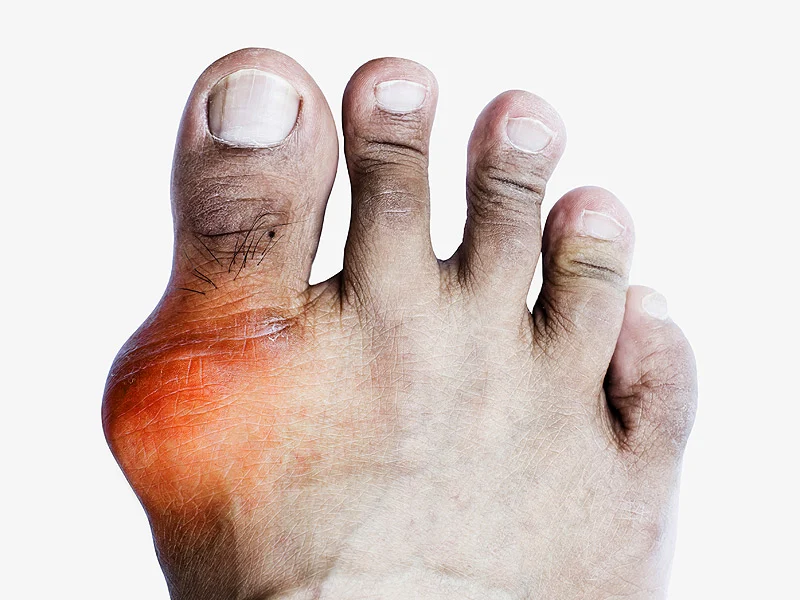Uric acid is the break down substances from Purines (Purines are normally produced in the body and are also found in some foods and drinks. Foods with high content of purines include liver, anchovies, mackerel, dried beans and peas and beer).
Most uric acid dissolves in blood and travels to the kidneys. From there, it goes out in the urine. If your body produces too much uric acid or kidneys do not remove enough of it, your uric acid in the blood goes up, called hyperuricaemia or gout. Normal Uric acid levels are 2.4-6.0 mg/dl (female) and 3.4-7.0 mg/dl (male).
What happens when Uric acid is high?
High uric acid levels is called Gout. This is a form of arthritis where crystals of uric acid form in your joints and cause intense pain.
You often feel it in your big toe, but can get it in your ankles, feet, hands, knees, and wrists, as well. It can also cause swelling, redness, and discomfort in those joints, and may limit your range of motion.
Most of the time, a high uric acid level occurs when your kidneys don’t eliminate uric acid efficiently.
Things that may cause this slow-down in the removal of uric acid include rich foods, being overweight, having diabetes, taking certain diuretics and drinking too much alcohol, Renal insufficiency (inability of the kidneys to filter waste), hypothyroidism, immune-suppressing drugs.
Other less common causes are a diet high in Purine-containing items.

What diet modification is needed?
Natural ways to lower uric acid
- Limit purine-rich foods, you can limit the source of uric acid in your diet. Purine-rich foods include some types of meat, seafood, and vegetables. All of these foods give off uric acid when they’re digested. Avoid or reduce your intake of foods such as: organ meats, pork, fish and shellfish, mutton, cauliflower, green peas, dried beans, mushrooms.
- Avoid sugary foods, while uric acid is usually linked to protein-rich foods, recent studies show that sugar may also be a potential cause. Added sugars to food include table sugar, corn syrup, and high fructose corn syrup, among others. The sugar fructose is a main type of simple sugar in processed and refined foods. Researchers have found that this type of sugar in particular could lead to high levels of uric acid. Check food labels for added sugars. Eating more whole foods and fewer refined packaged foods can also help you cut out sugars. Avoid sugary beverages Drink more water, drinking plenty of fluids helps your kidneys flush out uric acid faster.
- Avoid alcohol, Drinking alcohol can make you more dehydrated. It can also trigger high uric acid levels. This happens because your kidneys must first filter out products that occur in the blood due to alcohol instead of uric acid and other wastes. Some types of alcoholic drinks such as beer are also high in purines.
- Lose weight, Along with your diet, extra pounds can raise uric acid levels. Fat cells make more uric acid than muscle cells. Additionally, carrying extra pounds makes it harder for your kidneys to filter out uric acid.
- Add more fiber to your diet, eating more fiber will help your body get rid of uric acid. Fiber can also help balance your blood sugar and insulin levels. Add at least 5 to 10 grams of soluble fiber a day with whole foods such as: fresh, frozen, or dried fruit
- Reduce stress, Stress, poor sleeping habits, and too little exercise can increase inflammation. Inflammation may set off a high uric acid level.
What are the medicines available?
The first-line pharmacological urate lowering agent in gout is xanthine oxidase inhibitor therapy with either allopurinol or febuxostat. Nonsteroidal anti-inflammatory drugs, corticosteroids, or oral colchicine are the recommended first-line treatment for acute gout, and combinations of these medications can be used for severe or unresponsive cases.
Colchicine
This medication is used to prevent or treat gout attacks or flares. Mechanism of action: Colchicine works by decreasing swelling and lessening the build-up of uric acid crystals that cause pain in the affected joint. It works by inhibiting microtubule assembly in neutrophils.
Dose: 0.5 mg twice or 3 times daily.
Side effects: common side effects are nausea, vomiting and diarrhoea. Patients with both renal and hepatic impairment should not be given colchicine capsules.
Allopurinol
Allopurinol is a xanthine oxidase inhibitor which reduces the conversion of hypoxanthine and xanthine to uric acid hence decreases the uric acid produced by the body.
Dose: The recommended dose is 100 mg daily or 50 mg in older patients and in renal impairment. The average is 200 to 300 mg/day for patients with mild gout and 400 to 600 mg/day for those with moderately severe tophaceous gout.
Side effects: Diarrhoea, nausea, rash, maculopapular rash.
Febuxostat
Febuxostat is a xanthine oxidase inhibitor. Xanthine oxidase is needed to successively oxidize both hypoxanthine and xanthine to uric acid. Hence, febuxostat inhibits xanthine oxidase, therefore reducing the production of uric acid. It is useful in patients who fail to respond adequately to Allopurinol.
Dose: Recommended at 40 mg or 80 mg once daily. The recommended starting dose is 40 mg once daily. For patients who do not achieve a serum uric acid less than 6 mg/dL after two weeks with 40 mg, 80 mg is recommended.
The adverse effects associated with febuxostat therapy include nausea, diarrhoea, arthralgia, headache, increased hepatic serum enzyme levels and rash.